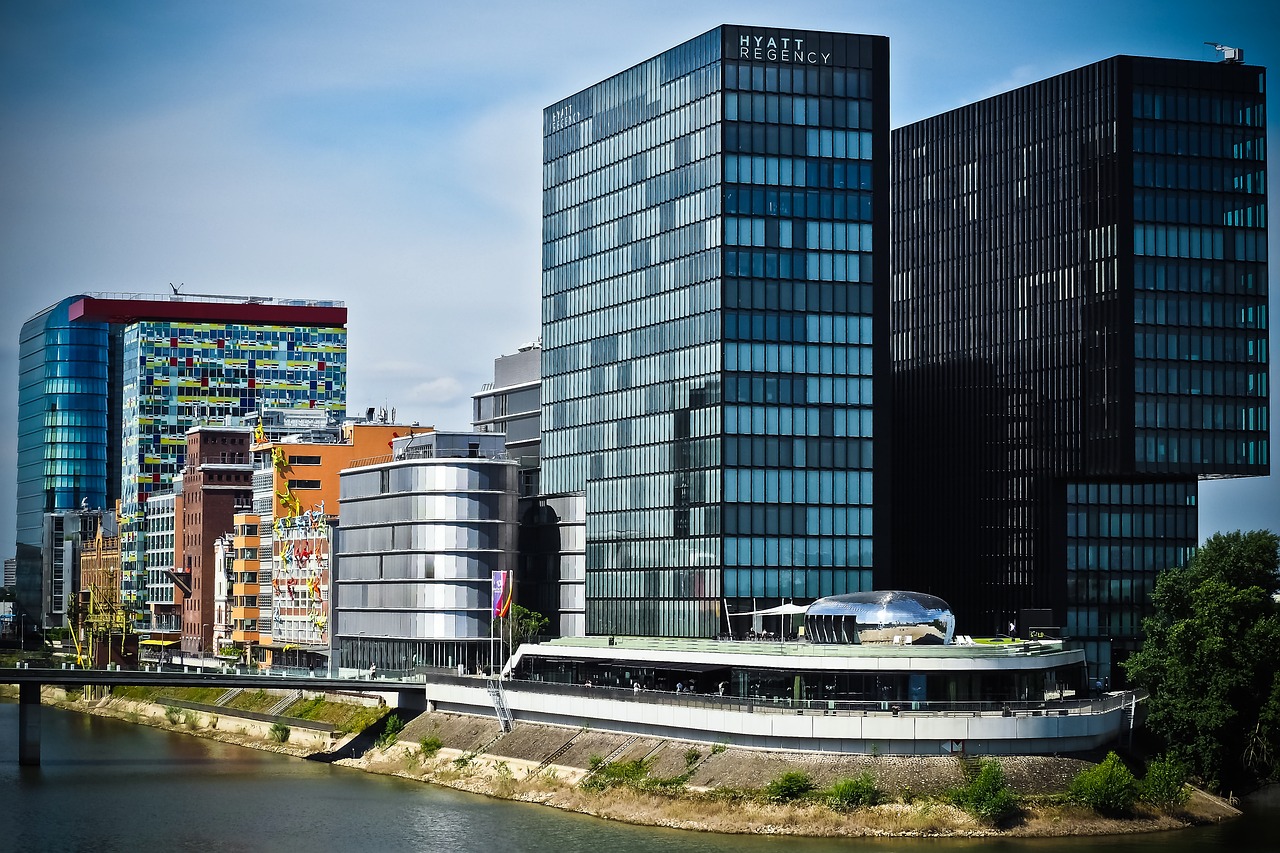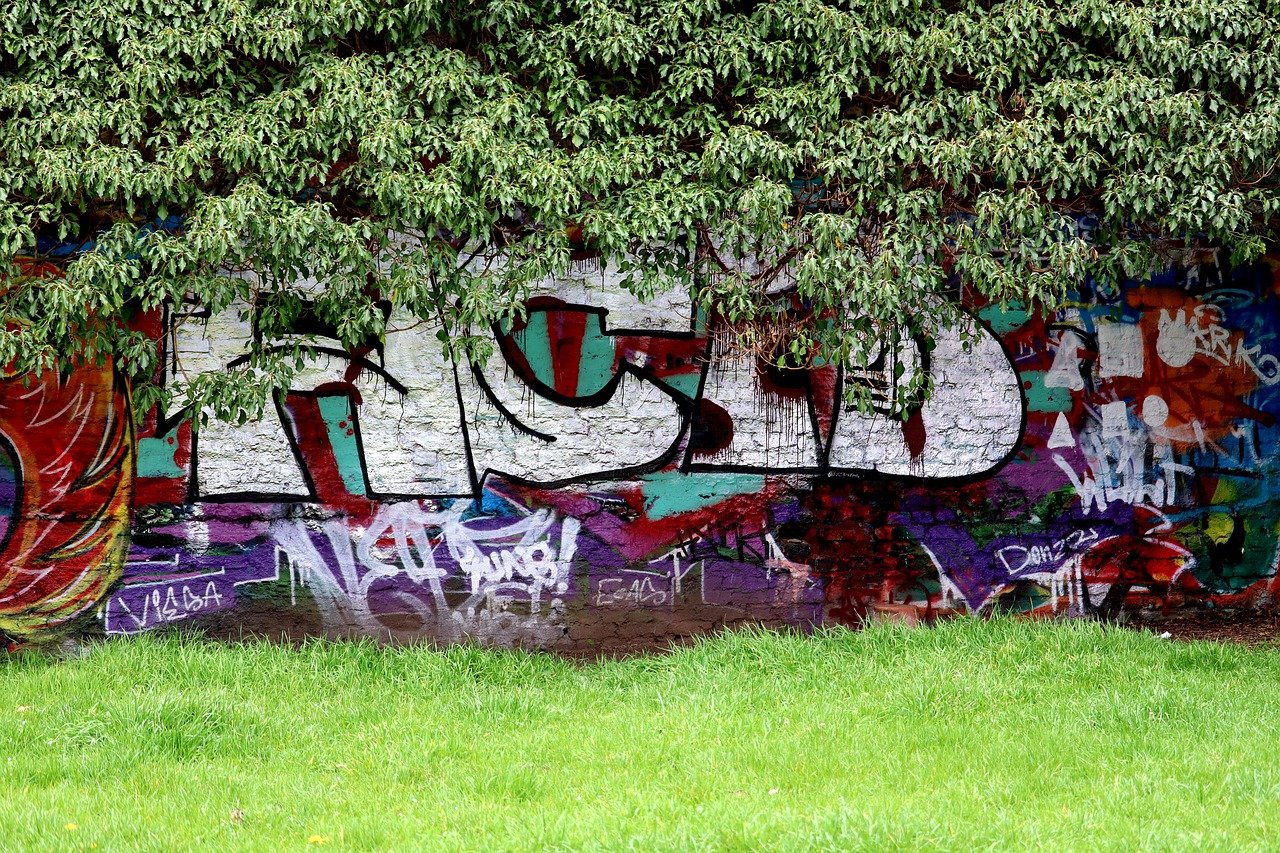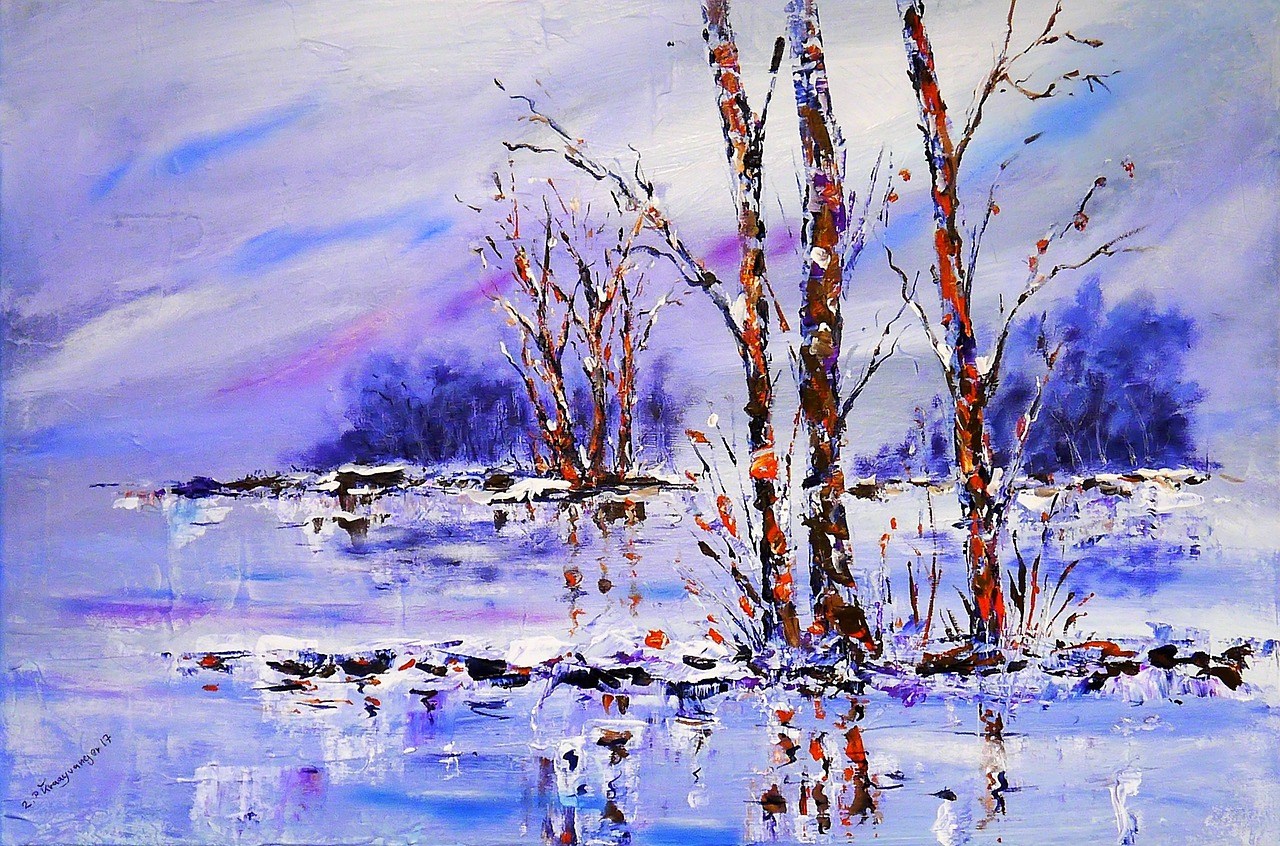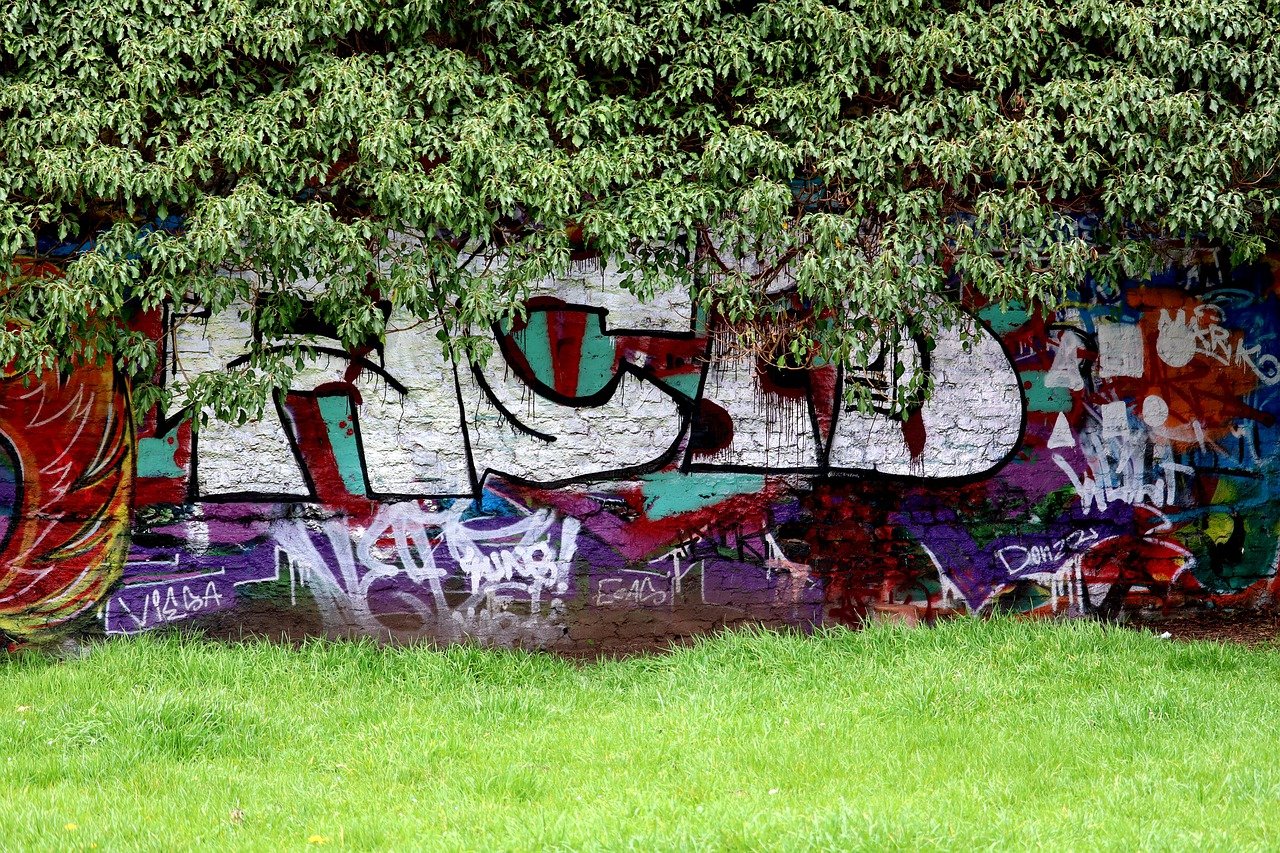Exploring Perspective: Cityscape Painting Techniques
Cityscapes are a vibrant tapestry of life, showcasing the hustle and bustle of urban environments. Painting these scenes is not just about capturing buildings and streets; it’s about conveying the essence of a city. In this article, we delve into various techniques that will elevate your cityscape paintings, focusing on the crucial aspects of perspective, composition, and color. Whether you're a seasoned artist or just starting out, mastering these elements can help you create stunning artworks that resonate with viewers.
Linear perspective is the backbone of creating depth in cityscape paintings. Imagine standing on a busy street, looking down a long avenue where buildings seem to converge at a point in the distance. This is the magic of vanishing points and horizon lines. By understanding these principles, artists can achieve realistic spatial relationships in their work. For instance, when you draw a street lined with buildings, using a vanishing point allows you to create a sense of depth that pulls the viewer into the scene. It’s like opening a window into another world!
Composition is the heart of any painting, and in cityscape art, it becomes even more crucial. A well-composed piece can guide the viewer's eye and evoke emotions. One technique that stands out is the rule of thirds, which involves dividing your canvas into a grid of nine equal sections. By placing key elements along these lines or at their intersections, you can enhance the balance and interest in your painting. This method transforms a simple city scene into a dynamic composition that captivates the audience.
The rule of thirds is not just a guideline; it’s a game changer. When you apply this principle, you’re effectively creating a visual roadmap for your audience. For example, if you position a prominent skyscraper at one of the intersections, it naturally draws the eye. This technique ensures that no part of the canvas feels neglected, resulting in a harmonious and engaging artwork. Think of it as orchestrating a symphony where every note has its place!
Focal points are essential as they draw the viewer's attention to the most important elements of your painting. In a cityscape, this could be a striking building, a bustling market, or a serene park. To establish a focal point, consider using contrasting colors, varying sizes, or unique shapes. This strategy not only highlights the focal area but also contributes to the overall narrative of the painting. Imagine a vibrant red building amidst a sea of gray; it’s impossible not to notice!
Leading lines are another powerful tool in the artist's arsenal. These lines guide the viewer's gaze through the painting, creating a sense of movement and depth. In cityscapes, roads, sidewalks, and even the edges of buildings can serve as leading lines. By strategically placing these lines, you can direct attention to key features, enhancing the overall composition. It’s like giving your audience a tour of the city, leading them from one captivating scene to the next.
Color theory plays a pivotal role in conveying mood and atmosphere in cityscape paintings. The colors you choose can evoke feelings of warmth, excitement, or even melancholy. For instance, vibrant yellows and oranges can create an energetic vibe, while cool blues and grays might convey a sense of calm or solitude. Understanding how colors interact and the emotions they evoke can help artists create more compelling works. Think of color as the emotional language of your painting!
Selecting the right tools and materials can significantly influence the outcome of your cityscape paintings. From brushes to paints, every choice matters. Here’s a quick overview of essential supplies:
| Tool/Material | Purpose |
|---|---|
| Brushes | Different shapes and sizes for various textures |
| Paints | Choosing between acrylics, oils, or watercolors |
| Surfaces | Canvas, paper, or wood panels for different effects |
Different brush techniques can produce unique textures and effects. Experimenting with various strokes, such as stippling or dry brushing, can add depth and interest to your cityscapes. Each stroke tells a story, and finding the right technique can be akin to discovering your artistic voice. Don’t shy away from trying new things; each attempt brings you closer to your signature style!
The choice of surface can impact the final look of your painting significantly. For instance, canvas offers a certain texture that can enhance the vibrancy of colors, while paper might provide a smoother finish. Understanding the characteristics of different surfaces will guide you in selecting the best option for your desired technique. It’s like choosing the right stage for your performance—each surface has its unique flair!
- What is the best medium for cityscape painting? It depends on your style! Acrylics are versatile and dry quickly, while oils offer rich colors and blending capabilities.
- How do I create depth in my cityscape? Use linear perspective and leading lines to guide the viewer's eye and create a sense of space.
- Can I use photographs as a reference? Absolutely! Photographs can help you capture details and proportions accurately.

Understanding Linear Perspective
Linear perspective is the magical tool that artists use to create a sense of depth and realism in their cityscape paintings. Imagine standing on a bustling street, where the buildings seem to stretch into the distance, converging at a single point on the horizon. This visual phenomenon is what linear perspective aims to replicate on canvas. At its core, linear perspective revolves around two fundamental concepts: vanishing points and horizon lines.
The horizon line represents the viewer's eye level in the painting. It’s the line where the sky meets the ground, and it serves as a reference point for all other elements in the artwork. The vanishing point, on the other hand, is where parallel lines appear to converge in the distance. Think of it as the ultimate destination for those lines that seem to stretch infinitely. In a cityscape, these points can be located anywhere on the horizon line, depending on the viewpoint you choose. Understanding how to manipulate these elements can make your cityscape painting not just a flat representation but a lively, dynamic space that draws the viewer in.
To master linear perspective, artists often start with a simple sketch. Draw a horizontal line across your canvas to establish the horizon line. Next, mark one or more vanishing points along this line. From these points, draw lines that extend outward to create the illusion of depth. This technique is particularly effective when depicting roads, sidewalks, or rows of buildings that seem to recede into the distance. By doing this, you’re not just painting a scene; you’re inviting your audience to step into your world.
But why stop at just one vanishing point? Advanced artists often employ two-point and three-point perspectives to create even more dramatic effects. In two-point perspective, you’ll have two vanishing points on the horizon line, perfect for depicting corners of buildings. In three-point perspective, a third vanishing point is added, typically above or below the horizon line, which can create a sense of towering height or deep depth. This technique is particularly useful for cityscapes filled with skyscrapers, where the vertical lines can dramatically draw the viewer's gaze upward.
To illustrate these concepts, let’s break down a simple example of how to apply linear perspective in a cityscape painting:
| Step | Description |
|---|---|
| 1 | Establish the horizon line across your canvas. |
| 2 | Identify one or more vanishing points on the horizon line. |
| 3 | Draw lines from the vanishing points to form the basis of your buildings and streets. |
| 4 | Add details to your buildings, ensuring that lines remain consistent with the perspective. |
| 5 | Finalize your painting with color and texture, bringing the cityscape to life. |
As you practice these techniques, remember that linear perspective is not just about rules; it's about capturing the essence of a bustling urban environment. Each city has its unique rhythm, and your painting should reflect that vitality. So grab your brushes, let your imagination roam, and watch as your cityscape takes shape with the enchanting power of linear perspective!
- What is the importance of linear perspective in painting? Linear perspective is crucial for creating depth and realism, allowing viewers to feel immersed in the artwork.
- How can I practice linear perspective? Start with simple sketches, focusing on establishing horizon lines and vanishing points, then gradually incorporate more complex scenes.
- Can I use linear perspective in other types of art? Absolutely! Linear perspective can enhance any artwork that involves depth, including landscapes and still life.

Choosing the Right Composition
When it comes to painting cityscapes, composition is like the backbone of your artwork. It’s what holds everything together and guides the viewer's eye through the scene. Think of it as the blueprint for your painting; without a solid structure, your cityscape might end up feeling chaotic or uninviting. A well-composed cityscape can evoke emotions, tell stories, and invite the viewer to step into the scene. So, how do you achieve that perfect composition?
One of the most effective ways to enhance your cityscape is by utilizing the Rule of Thirds. Imagine dividing your canvas into a grid of nine equal sections, much like a tic-tac-toe board. By positioning key elements along these lines or at their intersections, you create a more dynamic and engaging image. This technique not only adds balance but also draws the viewer’s eye to the most important parts of your painting. It's akin to placing a cherry on top of a sundae; it makes the whole piece more appealing.
In addition to the Rule of Thirds, establishing focal points is crucial. A focal point is essentially a visual anchor in your painting that grabs attention. It could be a striking building, a bustling street corner, or even a sunset reflecting off glass windows. To create an effective focal point, consider using contrasting colors, sharper details, or even unique shapes to make it stand out. This technique is like spotlighting a star performer in a play; it ensures that the audience knows where to look.
Moreover, incorporating leading lines can significantly enhance your composition. These are lines that guide the viewer’s gaze through the painting, often leading to the focal point. Think of roads, bridges, or even the edges of buildings that draw the eye inward. By effectively using leading lines, you can create a sense of depth and perspective, making the cityscape feel more immersive. It’s similar to a path in a garden that invites you to explore further.
When you combine these techniques—Rule of Thirds, focal points, and leading lines—you create a composition that is not only visually appealing but also rich in storytelling. Each element works together to guide the viewer through the narrative of your painting, making them feel as if they are part of the urban environment you’ve captured. So, the next time you sit down to paint a cityscape, remember that composition is your best friend. It’s the secret sauce that transforms a simple scene into a captivating work of art.
- What is the Rule of Thirds? The Rule of Thirds is a compositional guideline that suggests dividing your canvas into nine equal parts, placing key elements along these lines or their intersections for a balanced composition.
- How do I create a focal point in my painting? You can create a focal point by using contrasting colors, sharper details, or unique shapes to draw attention to the most important aspect of your cityscape.
- What are leading lines and why are they important? Leading lines are lines within your painting that guide the viewer’s eye towards the focal point, enhancing depth and perspective in your artwork.

Rule of Thirds Explained
The Rule of Thirds is a fundamental principle in visual arts, and when it comes to cityscape painting, it can be a game-changer. Imagine your canvas divided into a grid of nine equal sections, much like a tic-tac-toe board. This division creates four intersection points where the lines cross, and these points are where your eye naturally gravitates. By placing key elements of your cityscape along these lines or at their intersections, you can create a composition that feels balanced and dynamic. It's like setting a stage for a play; the actors (or in this case, the buildings and streets) are positioned in a way that draws the audience's attention without overwhelming them.
When applying the Rule of Thirds, think about the horizon line in your painting. Instead of positioning it smack dab in the center, try placing it along the top or bottom third of the canvas. This simple shift can dramatically alter the viewer's perception, allowing for a more engaging scene. For instance, if you're painting a bustling urban street, placing the horizon higher can emphasize the towering skyscrapers, while a lower horizon can showcase a vibrant sky filled with dramatic clouds.
Another effective technique is to use the intersections of the grid to highlight focal points within your cityscape. For example, if there's a stunning landmark, like a cathedral or a unique architectural structure, position it at one of these intersection points. This not only draws the viewer’s eye but also creates a sense of movement and flow throughout the artwork.
To illustrate how the Rule of Thirds can be applied, consider the following table that outlines different placements and their impacts:
| Placement | Description | Effect |
|---|---|---|
| Center | Placing the main subject in the center of the canvas. | Creates a static and less dynamic composition. |
| Top Third | Positioning the horizon line in the top third. | Emphasizes foreground elements, such as buildings. |
| Bottom Third | Horizon line in the bottom third. | Highlights the sky, creating a sense of openness. |
| Intersections | Placing focal points at the intersection points. | Draws attention and creates a sense of balance. |
In conclusion, the Rule of Thirds is more than just a guideline; it’s a powerful tool that can elevate your cityscape paintings from ordinary to extraordinary. By consciously applying this technique, you can create artworks that not only capture the essence of urban environments but also engage and captivate your audience. So, the next time you pick up your brush, remember to visualize that grid and let it guide you in crafting a stunning cityscape that tells a story!
- What is the Rule of Thirds? The Rule of Thirds is a compositional guideline that suggests dividing your canvas into a grid of nine equal parts and placing key elements along the lines and intersections.
- How does the Rule of Thirds improve my painting? By using the Rule of Thirds, you can create a more balanced and engaging composition, drawing the viewer's eye to important elements in your artwork.
- Can I break the Rule of Thirds? Absolutely! While it's a helpful guideline, breaking the rule can also lead to unique and interesting compositions. Experimentation is key!

Creating Focal Points
When it comes to painting cityscapes, is like setting the stage for a captivating performance. Just as a spotlight highlights the lead actor in a play, your focal points will draw the viewer's eye to the essential elements of your artwork. But how do you ensure that these focal points stand out? It’s all about strategic placement, contrast, and storytelling.
First, consider the placement of your focal point within the composition. A well-placed focal point can create a sense of balance and harmony. For instance, if you have a towering skyscraper in your cityscape, positioning it off-center can create a dynamic tension that pulls the viewer into the scene. This technique not only enhances visual interest but also invites the audience to explore the surrounding elements of your painting.
Next, think about contrast. Using contrasting colors or values can make your focal point pop. Imagine a bright red fire truck parked against a backdrop of muted greys and blues; the truck immediately becomes the star of the show. You can also employ variations in detail—adding intricate details to your focal point while keeping the background looser and less defined will naturally draw the viewer's attention. This technique can be particularly effective in cityscapes, where the hustle and bustle of urban life can often overshadow individual elements.
Another method to establish focal points is through leading lines. These are lines that guide the viewer's gaze towards the focal point. Think of the roads, sidewalks, or even the edges of buildings that can lead the eye directly to what you want to emphasize. For example, a winding street that leads to a vibrant market square can create a visual journey that not only highlights the focal point but also adds depth and perspective to your painting.
Incorporating light and shadow can also enhance your focal points. By manipulating light sources, you can create dramatic effects that highlight specific areas of your cityscape. A sunlit plaza surrounded by shadowy buildings can create a striking contrast that makes the plaza the focal point of your composition. Remember, light can be your best friend when it comes to directing attention.
Finally, consider the story you want to tell. Each focal point should contribute to the overall narrative of your cityscape. Whether it’s a bustling café, a serene park, or an iconic landmark, each element should resonate with the viewer and evoke emotion. Ask yourself: what do I want my audience to feel when they look at this painting? By answering this question, you can create focal points that not only stand out visually but also connect with the viewer on a deeper level.
In summary, creating effective focal points in your cityscape paintings involves a combination of strategic placement, contrast, leading lines, manipulation of light and shadow, and a compelling narrative. By mastering these techniques, you can transform your artwork from a simple depiction of urban life into a vibrant story that captivates and engages your audience.
- What is the purpose of a focal point in a painting?
A focal point directs the viewer's attention to the most important part of the artwork, creating a visual hierarchy and enhancing the overall composition. - How can I create a focal point without using bright colors?
You can use contrast, detail, and positioning to establish a focal point. Even muted colors can stand out if they are strategically placed in relation to the rest of the painting. - Can I have more than one focal point in a cityscape?
Yes, you can have multiple focal points, but be careful to maintain balance and ensure that they do not compete for attention. Each focal point should support the overall narrative.

Utilizing Leading Lines
When it comes to painting cityscapes, leading lines are like the invisible threads that weave your composition together. They guide the viewer's eye through the artwork, creating a sense of movement and depth. Imagine standing on a bustling street corner, where the roads and sidewalks converge in a mesmerizing dance. This is the magic of leading lines! They can be anything from the edges of buildings, the paths of roads, or even the lines formed by fences and railings. The key is to identify these elements in your urban environment and use them to your advantage.
Incorporating leading lines effectively can transform a flat painting into a vibrant experience that pulls the viewer in. For example, consider a scene where a long avenue stretches out before you, flanked by towering skyscrapers. The lines created by the edges of the buildings can lead the eye toward the horizon, creating a sense of distance and scale. This technique not only adds depth but also helps to establish a visual narrative. The viewer is not just looking at a city; they are embarking on a journey through it.
To effectively utilize leading lines in your cityscape paintings, keep these tips in mind:
- Identify Natural Lines: Look for existing lines in your environment. These could be roads, sidewalks, or even the contours of buildings. Make them prominent in your painting.
- Draw the Eye: Use leading lines to draw attention to key elements in your artwork. Whether it’s a stunning skyscraper or a quaint café, make sure these focal points stand out.
- Experiment with Angles: Don’t be afraid to play with perspective. Sometimes, a slight shift in angle can enhance the leading lines and create a more dynamic composition.
Another effective strategy is to create diagonal lines. They add a sense of energy and movement to your painting. For instance, if you’re painting a busy intersection, the paths of vehicles and pedestrians can create dynamic diagonal lines that guide the viewer’s gaze across the canvas. This not only enhances the sense of action but also makes your painting feel alive.
Remember, the ultimate goal of using leading lines is to create a visual journey for your audience. Think of it as crafting a path through your cityscape, where each line leads to a new discovery. By skillfully incorporating these lines, you can elevate your artwork from a simple representation of a city to a captivating experience that resonates with viewers.

Color Theory in Cityscapes
This article delves into various techniques for painting cityscapes, focusing on perspective, composition, and color. Learn how to enhance your artwork and capture the essence of urban environments through effective methods.
Linear perspective is essential for creating depth in cityscape paintings. This section explores the principles of vanishing points and horizon lines, helping artists achieve realistic spatial relationships in their work.
Composition plays a crucial role in cityscape painting. This section discusses different compositional techniques, including the rule of thirds and focal points, to guide artists in creating visually appealing artworks.
The rule of thirds is a fundamental compositional guideline. Here, we explain how dividing the canvas into thirds can enhance balance and interest in cityscape paintings, leading to more engaging results.
Focal points draw the viewer's eye. This subsection discusses strategies for establishing focal points in cityscapes, ensuring that important elements stand out and contribute to the overall narrative of the painting.
Leading lines can guide the viewer's gaze through a painting. This section explores how to effectively incorporate leading lines in cityscapes, enhancing depth and directing attention to key features.
Color theory is vital for conveying mood and atmosphere in cityscape paintings. The colors you choose can dramatically influence the emotional impact of your artwork, transforming a simple city scene into a vibrant narrative. Think of colors as the emotional language of your painting; they can evoke feelings of warmth, nostalgia, or even melancholy. For instance, a sunset cityscape painted with warm oranges and pinks might inspire feelings of comfort and peace, while a rainy city scene with cool blues and grays can create a sense of isolation or introspection.
When selecting colors, consider the following aspects:
- Hue: The actual color itself, like red, blue, or yellow.
- Saturation: The intensity or purity of a color. A highly saturated color will stand out more, while a desaturated color can create a more muted effect.
- Value: The lightness or darkness of a color, which can influence the overall mood of the piece.
To illustrate how different colors can affect the perception of a cityscape, let's look at a simple table:
| Color | Emotion Conveyed | Example Usage |
|---|---|---|
| Warm Reds | Energy, Passion | Busy downtown scenes |
| Cool Blues | Calm, Sadness | Quiet streets at dusk |
| Soft Greens | Peace, Renewal | Park areas within a city |
| Bright Yellows | Joy, Optimism | Sunlit buildings |
As you experiment with colors in your cityscape paintings, think about the story you want to tell. Are you capturing a bustling city at noon, filled with energy and life? Or perhaps a quiet, rain-soaked street at night, where shadows loom and lights glimmer? Each choice you make can lead the viewer to feel a certain way, making your artwork not just a depiction of a city, but an experience that resonates on a deeper level.
Selecting the right tools and materials can significantly influence the outcome of cityscape paintings. This section reviews essential supplies, including brushes, paints, and surfaces, to help artists achieve their desired effects.
Different brush techniques can produce unique textures and effects. This subsection discusses various brush strokes suitable for cityscapes, encouraging experimentation to find the perfect style for your artwork.
The choice of surface can impact the final look of a painting. This section examines different surfaces, such as canvas and paper, and their suitability for cityscape techniques, guiding artists in their selection process.
- What is the best color palette for cityscape paintings? It depends on the mood you want to convey. Warm colors can create a lively atmosphere, while cool colors can evoke calmness or melancholy.
- How can I improve my perspective in cityscape paintings? Practice using vanishing points and horizon lines. Sketching from real-life scenes can also help you understand spatial relationships better.
- What materials do I need to start painting cityscapes? Essential materials include quality brushes, acrylic or oil paints, and a suitable surface like canvas or watercolor paper.

Tools and Materials
When it comes to painting cityscapes, the tools and materials you choose can make all the difference in the outcome of your artwork. Just like a chef needs the right utensils to create a culinary masterpiece, an artist requires specific supplies to bring their urban visions to life. Choosing the right brushes, paints, and surfaces is crucial for achieving the desired effects and ensuring your cityscape resonates with viewers. So, let’s dive into the essentials!
First off, let’s talk about brushes. Different brushes can create a variety of textures and effects, which is especially important in cityscapes where you want to capture everything from the sleek glass of skyscrapers to the rough textures of brick buildings. A good starting point would be to have a range of brushes, including:
- Flat Brushes: Perfect for broad strokes and filling in large areas.
- Round Brushes: Great for detailed work and fine lines.
- Fan Brushes: Useful for creating texture, especially in foliage or clouds.
Next, the choice of paints is equally vital. Whether you prefer watercolors, acrylics, or oils, each medium has its unique properties that can affect your painting style. For instance, acrylics dry quickly and allow for layering, making them ideal for building depth in cityscapes. On the other hand, oils offer a rich texture and longer drying time, which can be beneficial for blending colors seamlessly. Consider experimenting with different brands and formulations to find the ones that suit your technique best.
Another key element is the surface on which you paint. The texture and absorbency of the surface can significantly influence the final look of your cityscape. Here are some common surfaces to consider:
| Surface Type | Best For |
|---|---|
| Canvas | Oils and acrylics, great for texture |
| Watercolor Paper | Watercolors, excellent absorbency |
| Wood Panels | Mixed media, sturdy and smooth |
Lastly, don’t forget about other materials that can enhance your artwork. Items like palette knives for mixing, sponges for texture, and even masking tape for clean edges can elevate your cityscape paintings. It's all about finding what works best for you and your artistic vision.
In conclusion, the right tools and materials are essential for creating stunning cityscape paintings. By investing in quality brushes, paints, and surfaces, you set yourself up for success. Remember, every artist has their unique preferences, so take the time to explore and experiment until you find the perfect combination that brings your urban landscapes to life!
Q: What type of paint is best for beginners?
A: Acrylic paints are often recommended for beginners due to their versatility, quick drying time, and ease of use.
Q: Can I use regular paper for painting cityscapes?
A: While you can use regular paper, it's best to use watercolor or acrylic paper, as they are designed to handle the moisture and texture of paint.
Q: How do I choose the right brush for my painting?
A: It depends on the effect you want to achieve. Flat brushes are great for large areas, while round brushes are better for details. Experiment to see what works best for you!

Brush Techniques
When it comes to painting cityscapes, the you choose can dramatically influence the final outcome of your artwork. Different strokes can evoke various textures and feelings, making your painting not just a representation of a city but an emotional experience for the viewer. Imagine standing in front of a bustling street; the energy, the movement, and the atmosphere can all be captured through the right brushwork. So, let’s dive into some techniques that can elevate your cityscape paintings to new heights!
One of the most popular techniques is the dry brush technique. This method involves using a brush with very little paint on it, allowing the texture of your canvas or paper to show through. It’s perfect for creating the rough textures of brick buildings or the delicate details of tree branches swaying in the urban breeze. By applying this technique, you can add a layer of authenticity to your city scenes, making them feel alive and vibrant.
Another technique worth exploring is the wet-on-wet technique. This approach involves applying wet paint onto wet paint, which can create beautiful, soft blends and gradients. It’s particularly effective for capturing the hazy atmosphere of a sunset over a city skyline. Picture the sun dipping below the horizon, casting a warm glow on the buildings; using this technique can help you replicate that magical moment on your canvas. Just remember, it requires a bit of practice to master, as the paint can easily become muddy if not done carefully.
For those who enjoy a bit of structure, the stippling technique can be a game-changer. It involves applying small dots or strokes of color to build up texture and depth. This method is fantastic for detailing elements like windows or streetlights, giving them a vibrant, illuminated effect. The key here is patience; it may take some time to fill in your desired areas, but the result is often worth the effort.
If you're looking for something a bit more dynamic, consider the splatter technique. This playful approach can add an element of surprise to your cityscape, mimicking the effect of rain or the bustling energy of a city. Just be sure to protect your workspace, as things can get a little messy! Using a toothbrush or a stiff-bristled brush can help you achieve this effect; simply dip it in paint and flick it onto your canvas for an exciting, spontaneous look.
Lastly, don’t underestimate the power of layering. Building up layers of color can create depth and richness in your cityscape. Start with a base layer of color and gradually add additional layers, allowing each one to dry in between. This technique can create a sense of realism, making the viewer feel as though they could step right into your painting.
To summarize, here are some essential brush techniques to consider for your cityscape paintings:
- Dry Brush Technique - For rough textures and details.
- Wet-on-Wet Technique - For soft blends and atmospheric effects.
- Stippling Technique - For detailed elements like windows.
- Splatter Technique - For dynamic, energetic effects.
- Layering - For depth and richness.
Experimenting with these techniques can lead to exciting discoveries in your artwork. Remember, the beauty of painting lies in your ability to express your unique vision of the urban landscape. So grab your brushes, and let your creativity flow!
Q: What type of brushes should I use for cityscape painting?
A: It’s best to have a variety of brushes, including flat, round, and detail brushes. Each serves a different purpose and can help you achieve various effects.
Q: Can I use acrylics for cityscape painting?
A: Absolutely! Acrylic paints are versatile and dry quickly, making them perfect for layering techniques commonly used in cityscapes.
Q: How do I choose the right colors for my cityscape?
A: Consider the mood you want to convey. Warm colors can evoke feelings of warmth and energy, while cooler colors can create a calm or somber atmosphere.

Surface Selection
When it comes to painting cityscapes, the is a crucial factor that can dramatically influence the outcome of your artwork. The choice between different surfaces like canvas, paper, or wood can shape not only the texture but also the overall feel of the painting. Each surface has its own unique characteristics, and understanding these can help you make an informed decision that aligns with your artistic vision.
Canvas is perhaps the most popular choice among artists for its durability and versatility. It can handle a variety of mediums, from oil to acrylic, and provides a textured surface that can add depth to your cityscape. However, it's essential to consider the type of canvas you choose. For instance, stretched canvas offers a firm surface ideal for heavy applications of paint, while canvas boards are more portable and can be great for studies or smaller works.
On the other hand, watercolor paper is a fantastic option if you're looking to create ethereal cityscapes with soft washes and delicate details. This type of paper is designed to absorb water without warping, allowing for fluid brushwork and vibrant colors. If you’re aiming for a more textured look, you might want to consider cold-pressed watercolor paper, which has a pronounced texture that can add an interesting dimension to your cityscape.
Another option worth exploring is wood panels. They provide a smooth, rigid surface that is excellent for detailed work and can hold up well under various mediums. The natural grain of the wood can also add a unique aesthetic to your painting, making it stand out. However, it’s essential to prepare the wood properly by priming it to ensure that the paint adheres well and to prevent any damage to the wood over time.
To help you visualize the differences between these surfaces, here’s a quick comparison table:
| Surface Type | Best For | Characteristics |
|---|---|---|
| Canvas | Oils, Acrylics | Durable, Textured |
| Watercolor Paper | Watercolors | Absorbent, Smooth or Textured |
| Wood Panels | Mixed Media | Rigid, Smooth |
Ultimately, the best surface for your cityscape painting will depend on your personal style and the specific effects you wish to achieve. Don’t hesitate to experiment with different surfaces to discover what resonates with you. After all, art is about exploration and finding your unique voice!
- What is the best surface for beginners? Canvas boards are great for beginners as they are affordable and easy to work with.
- Can I use acrylics on watercolor paper? Yes, acrylics can be used on watercolor paper, but it’s advisable to use a heavier weight paper to prevent warping.
- How do I prepare a wood panel for painting? Sand the surface lightly and apply a layer of gesso to create a suitable base for paint.
Frequently Asked Questions
- What is linear perspective and why is it important in cityscape painting?
Linear perspective is a technique that helps artists create the illusion of depth in their paintings. By using vanishing points and horizon lines, artists can accurately depict spatial relationships, making their cityscapes look more realistic and three-dimensional. Imagine standing on a busy street, where buildings seem to converge at a point in the distance; that’s the magic of linear perspective!
- How can I improve my composition when painting cityscapes?
Improving your composition involves understanding and applying techniques like the rule of thirds and establishing focal points. The rule of thirds suggests dividing your canvas into a grid, placing key elements along these lines or their intersections. This creates balance and draws the viewer’s eye naturally across your artwork. Think of it as arranging a beautiful bouquet; each flower needs its space to shine!
- What are focal points, and how do I create them in my paintings?
Focal points are the areas in your painting that grab the viewer's attention first. To create them, you can use contrast, color, and placement. For example, if you paint a bright red building against a muted background, that red building becomes the focal point. It’s like highlighting the star of a show; everything else should support that star!
- How do leading lines enhance a cityscape painting?
Leading lines are pathways that guide the viewer’s eyes through your artwork. They can be roads, rivers, or even the edges of buildings. By using leading lines effectively, you can create a sense of movement and direction, leading your audience to the focal point of your painting. It’s similar to how a good story unfolds, drawing readers deeper into the narrative!
- Why is color theory important in cityscape painting?
Color theory is essential because it helps convey mood and atmosphere in your paintings. Different colors evoke different emotions; for instance, warm colors can create a sense of excitement, while cool colors can evoke calmness. Understanding how to mix and apply colors can significantly enhance the emotional impact of your cityscapes, making them more compelling and engaging.
- What tools and materials do I need for cityscape painting?
To get started with cityscape painting, you’ll need some essential tools and materials such as quality brushes, a range of paints (acrylics or oils), and suitable surfaces like canvas or watercolor paper. Each tool can produce different effects, so it’s worth experimenting to find what works best for your style!
- What brush techniques work best for painting cityscapes?
There are various brush techniques to explore, such as dry brushing for texture, washes for smooth backgrounds, and stippling for adding detail. Each technique can bring a unique flair to your cityscape, so don’t hesitate to play around and discover what resonates with your artistic vision!
- How does the choice of surface affect my painting?
The surface you choose can greatly influence the final look of your painting. Canvas provides a textured feel, while smooth paper can offer precision. Different surfaces absorb paint differently, which can affect color vibrancy and texture. Think of it like choosing the right fabric for a dress; it can make all the difference in how it turns out!



















